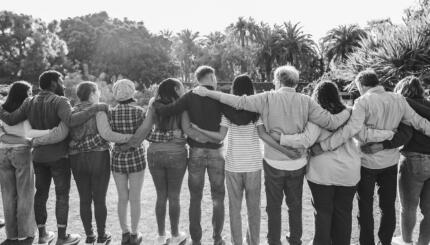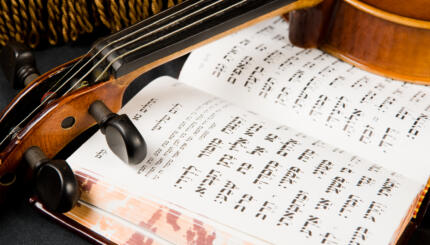As much as a synagogue is a prayer community, it is also a place where Jews gather in order to socialize, be educated, commit to social action, be inspired, and gain counsel. Although communities with smaller Jewish populations may be “one-synagogue-towns,” larger metropolitan areas often provide Jews with a variety of different synagogues from which to choose.
No one synagogue is likely to satisfy all of your needs. But, it is important to find the best match between you and your chosen congregation. Each synagogue, or , has its own character or personality. The shul’s personality is reflected in the behavior of its members, clergy, ritual style and services. Taking the time to think about what you are seeking from a synagogue community and how that corresponds to the available options is the first step in creating a meaningful connection with a synagogue.
Doing Your Homework
Today, it is easy to gather a great deal of information regarding local synagogues without leaving your home. The first step is to find the names and locations of local shuls.
You can also check the website of your local Jewish federation (if one exists) or search the Internet for “synagogue” plus your hometown and state. Larger Jewish communities often have a local board of rabbis, which you can also contact for information. Most synagogues in North America have their own websites. Learn how to find local Jewish resources here.

Help us keep Jewish knowledge accessible to millions of people around the world.
Your donation to My Jewish Learning fuels endless journeys of Jewish discovery. With your help, My Jewish Learning can continue to provide nonstop opportunities for learning, connection and growth.
Friends may also be a reliable source of recommendations and information, and they may also point you to alternative Jewish communities —such as havurot (small, informal Jewish community groups) and lay-led s (prayer gatherings of at least 10 Jewish adults) — that may meet inside a synagogue or exist independently.
The second step is to gather information about each congregation. Websites can give you a great glimpse at the personality of the congregation, its programs, and the types of services it provides. Many synagogues also produce membership packets that you can find on their websites or request.
Even with the accessibility of information, there is no substitute for visiting the congregations you are considering. Before you go in person, you may want to see if the synagogue has an archive of services that they have live-streamed on the Internet. On such visits, be sure to sit in on a or holiday service, meet with professional staff and socialize with both new and veteran members. Synagogues with well-organized membership committees may provide you with a “host,” a member (or family) of the congregation who can give you a tour, sit with you during services or activities, and follow-up with you by phone later.
Denominations
Many Jews identify with a particular Jewish congregational movement. Others reject denominational labels or find the differences among the denominations to be confusing. In addition, the denominational scene in North America has changed considerably in recent years with the addition of new expressions of Judaism. (You can find information on the different denominations here.)
It is important to understand that even within a movement, synagogues vary widely in their style of services, ritual observances, and congregational structures. For example:
- Some Conservative synagogues use musical instruments on Shabbat, while others do not. Conservative synagogues also vary in how much Hebrew they use in prayer and the extent to which they adhere to traditional liturgy or use modern alternatives. A very small number of Conservative congregations are not egalitarian, meaning women are not counted toward a minyan and cannot lead services.
- Reform synagogues likewise differ on the Hebrew-English balance in services, and in the length of their services.
- Orthodox congregations differ in how women participate in the service, including whether they can lead certain prayers, read from the Torah or (in a small minority of cases) serve as the spiritual leader of the congregation. Some hold women’s-only minyanim, others do not.
- Though the denominations have official stances on how they treat gay, lesbian, bisexual, and transgendered Jews, congregations within each movement differ in how those policies are enacted.
A growing number of congregations have chosen not to align themselves with a particular movement for practical and/or philosophical reasons. Smaller, newer congregations often do not affiliate because they feel they cannot afford movement dues. Congregations with spiritual leaders who have not been trained by the conventional rabbinical programs often do not belong to a denomination and frequently view themselves as standing outside the institutions of mainstream Judaism. Some congregations are too eclectic in their observances, beliefs, and practices to feel represented by any of the movements.
Generally, it is a good idea to ask why an unaffiliated congregation has chosen to remain so, although this alone is not usually a reason to eliminate a congregation from consideration.
What Type Will Serve Me Best?
When contemplating membership in a synagogue, many adults find that they reflect on the synagogue(s) in which they have participated in the past. Such reflection is important, even if it gives you a list of what you don’t want a congregation to be. It is important to know yourself and what you and/or your family would like in a congregational community. Ask yourself the following:
- Would I prefer a smaller synagogue where I’d be likely to get personal attention or a larger congregation which offers more services and activities? Larger congregations provide a greater variety of prayer services, schooling options, activities for children and adults, professional leadership, and facility uses. A smaller congregation usually will be more tightly knit, have one rabbi (or none), and have fewer options in programs and activities. Some individuals feel lost in the crowd at a large synagogue. Others feel they cannot find the resources they need at a smaller congregation.
- Do I want a synagogue of people uniformly at or near my observance level? Do I prefer a synagogue that aspires to a level of observance I can work toward?
- How near to my home must a synagogue be? Remember that the types of activities in which you and/or your family participate will determine the frequency at which you travel this distance round-trip.
- Do I prefer services with or without musical accompaniment? Many congregations make use of musical instruments in their services to enhance the beauty and inspirational power of the prayer experience. Orthodox, most Conservative, and other traditional synagogues do not use instruments, since the playing of instruments on Shabbat and holidays is forbidden according to their understanding of halacha (Jewish law).
- Do I prefer services with more or less Hebrew? Regardless of Hebrew ability, there are plenty of people for whom a service with English readings just doesn’t feel comfortable. Others–having little reading ability in or comprehension of Hebrew–find an all-Hebrew service to be uncomfortable. Even some who are fluent in Hebrew find that a few English readings enhance the participatory feeling of a service.
- How much do I want to spend on synagogue dues and other fees? Synagogues vary widely on this issue–and many expect (or require) members to pay certain annual fees, such as a payment to the building fund, above and beyond dues.
What Resources Do I Need?
The next step is to assess what resources you might need or prefer from a shul.
Rabbi
Not all congregations have rabbis. Smaller congregations may have a rabbi who only works part-time. Rabbis serve different roles in different congregations. Some focus primarily on organizing the ritual life of the congregation–leading and speaking at services, conducting lifecycle events, and arranging holiday celebrations. Others leave much of that to lay leaders or the cantor. There are rabbis whose role is largely pastoral, providing counseling, serving as a chaplain at the local hospital, and working one-on-one with individuals exploring their Jewish paths. Teaching is often a major pursuit of a rabbi in a congregation.
Religious School
Many synagogues in North America have an after-school and/or Sunday-school program or a day-long program of secular and Jewish studies. A congregation might also have a preschool.
Children’s Programming for Shabbat and Holidays
A significant number of synagogues provide special services and activities for young children and teens.
Special Interest Groups
Most synagogues have groups (Israel advocacy, teens, singles, older adults, sisterhood, brotherhood) or havurot. that provide additional programming and more intimate communities within the larger synagogue.
Adult Education
Does the synagogue have an adult education program and/or a learners’ service? Learning is a spiritual experience highly emphasized in Judaism. Today, many congregations provide lifelong learning opportunities.
Accessibility
Are the facility and its programs accessible to individuals with physical, mental, or developmental disabilities? Some communities have older buildings that have not yet been remodeled for wheelchair access to their main entrance and/or their (the stage-like, elevated area at the front of many synagogue sanctuaries). Some religious schools may not feel equipped to educate blind, hearing-impaired, or developmentally challenged students. Others are ability to fully welcome Jews with disabilities to their services and schools.
Debrief Yourself
When you have gathered all your research, interviewed community members and staff, and visited the congregation, don’t forget to process your feelings regarding the community. Ask yourself the following questions:
- How was I treated when I made my inquiries and visited? Did staff and members go out of their way to make me feel welcome?
- Do I feel comfortable participating in their services?
- Do I feel like I can connect to the rabbi and/or cantor?
- Did I feel like I fit in? Were there congregants present at my stage of life?
In the end, you are the only judge as to the fit of a congregation. Choosing a shul and community are not permanent decisions, and it is worthwhile to reassess your affiliation if you feel uncomfortable with your congregation at any time. However, for many people, a synagogue can be a lasting community, a second home, a place for learning and celebrating, and an extended family.



